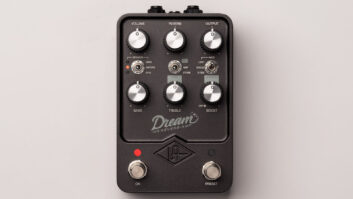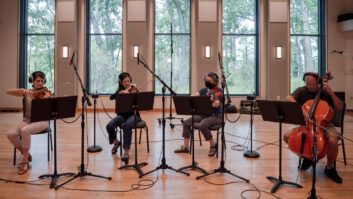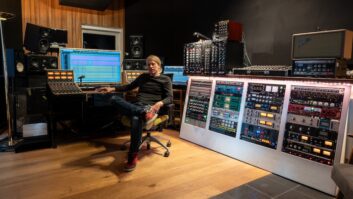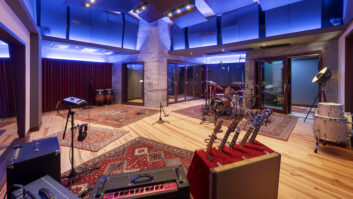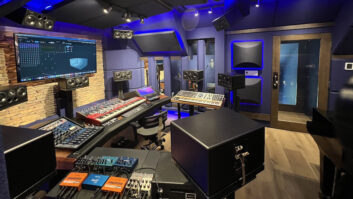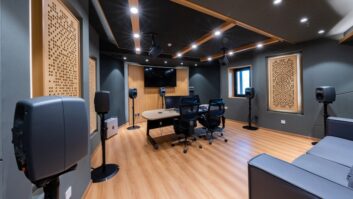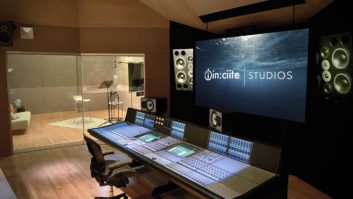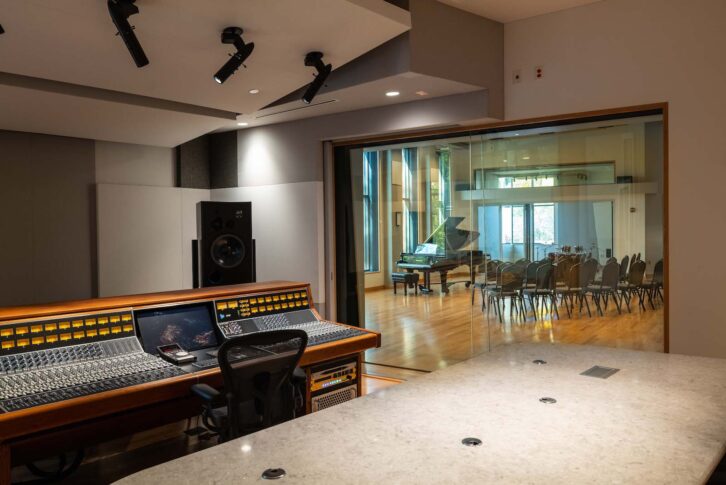
There is almost always somebody in any band who takes an interest in the technical aspects of the production process. “I was that guy,” says Greg Miner, a musician, producer and engineer who has just opened Philharmonic Studios in Chicago’s northern suburb of Vernon Hills.
Miner, who took up guitar as a youngster, initially embraced the road life. “But I got tired of sleeping in bad hotels and in vans and buses,” he says. “I graduated from Full Sail in the Nineties, came back to Chicago and did an internship at Chicago Recording Company, then just started freelancing and honing my craft, biding my time and nursing the idea of having a facility someday. And here I am.”
Recording Jane Ira Bloom’s ‘Picturing the Invisible: Focus 1’
Here he is, indeed, with a purpose-built complex set in a stand of trees on the edge of a business park 20 minutes from O’Hare Airport and 45 miles from downtown Chicago. The outside finishes of Lake Forest, Ill.-based Melichar Architects’ building design echo the surrounding woodland. Inside, Miner says, “I wanted to combine the best aspects of the classic facilities with the advantages of modern workflows.”
He called in the Russ Berger Design Group to provide architectural and acoustical design for the 7,000-square-foot, three-room layout. Berger, headquartered in Plano, Texas, recommended Paul J. Cox Studio Systems in Los Angeles to handle technical integration. Vintage King Audio consultants James Good and Frank Verschuuren took the lead on equipment acquisition, expanding on the collection Miner had amassed during the past 30 years, and installed some of the gear.
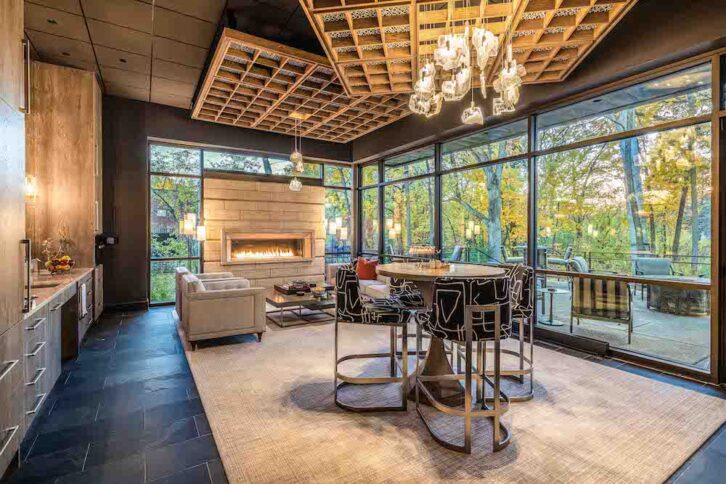
Studio A features a side-address control room with floor-to-ceiling glass, an RBDG design hallmark, overlooking a spacious live space surrounded by three dedicated iso booths, plus an entrance/airlock, all flooded with natural light.
“Studio B can handle Dolby Atmos mixing, but we can also do stereo mastering in that room,” Miner says. “Studio C is more of a modern workflow room geared toward EDM, pop and hip-hop.”
All three rooms in Philharmonic Studios are interconnected. “An artist can book out the entire facility, and we can have different personnel working on the same project simultaneously from different places, exchanging files without having to reach for the thumb drive,” he says.
Cox and his integration crew provided interconnectivity in any format, including analog, AES, Dante and video. Even if there’s a big production in the A room, an iso booth can be used as a small control room or editing suite. “Rooms that have direct sightlines have direct ties, aside from the regular studio infrastructure,” Cox notes. “Anything with no line-of-sight, like Studio C, is connected via the machine room.”
Classic Tracks: Martina McBride’s “Independence Day”
The A control room sports a 40-channel API 2448 all-discrete console and ATC monitor system. “I’ve been using API products for a number of years,” Miner reports, “so I was used to the sound, the workflow and the service from the company. The board has everything you need to conduct a large-scale tracking session. It’s good for cue mixes and things like that; the workflow is excellent. And it doesn’t break the bank in terms of monthly operating costs— meaning, it doesn’t generate a lot of heat.”
A credenza houses four bays of outboard gear, including various processing and preamp options. “I’m a big fan of outboard mic preamps, so I have quite a few of those,” Miner confirms. “I can use the console pre’s or go straight into the converters and just use the console as a monitor section.”
Neve is another favored brand. Miner has quite a collection scattered about the building, including 1073, 1081 and 1084 Classic modules and remote-controlled, multichannel 1073OPX and 1081R rack units, plus a 33609/N compressor. A Neve BCM10/2 MK II fitted with two dozen 1084 modules sits on a movable stand. “It’s a floating desk that lives in the A control room,” Miner says. “I’ve got a half-inch machine, and the Neve just sounds fantastic as a front end. It’s a great resource for people who want to track live-to-2-track. It’s great for rock ‘n’ roll drums or cutting a whole band in the old style, which is exciting and immediate. That’s something that’s lacking, I think, in a lot of today’s methodically assembled work.”
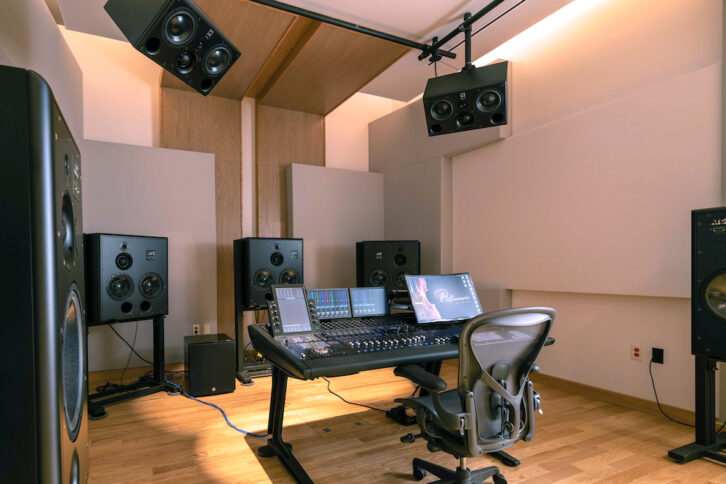
Studio B is outfitted for immersive mixing with an Avid S6 worksurface, Dolby Atmos renderer and an ATC 7.1.4 monitor system. “I really like ATC for its midrange clarity, tonal neutrality, lack of distortion and excellent imaging, and they don’t flatter the material,” says Miner, who has long used ATC SCM20 and SCM25 nearfields. “You have to work a little bit to make them sound good, but when you do, you can be confident everything will translate.”
Studio B was originally going to be a stereo mastering room, but Miner was inspired to switch things up after visiting the big Atmos room at Blackbird Studio in Nashville. “I could see all kinds of creative possibilities for the format,” he says. “I think it’s one of the most significant developments in audio in a long, long time.”
While other facilities are mostly mixing catalog tracks for Apple’s Spatial Audio and other streaming platforms, Miner has a larger vision for Philharmonic. “There are very few people creating new content in the format, so this is an area where I’m hoping that Philharmonic will lead the pack,” he says, noting the expansive live room’s potential for spatial microphone arrays.
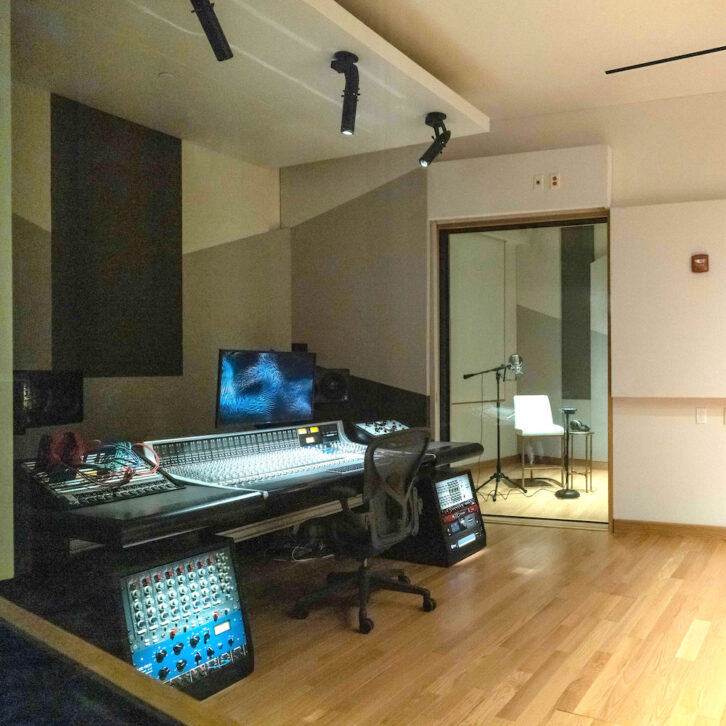
Philharmonic Studios’ Studio C features an SSL AWS924 analog desk and racks of outboard. The attached vocal booth is suitable for overdub and voice-over work, as well as songwriting or modern music production, and the room can also tap into any other live space, of course, including with a video link.
Miner previously tried his hand at building out spaces in downtown Chicago, but fitting into an old building forced him to make design compromises. “Doing a retrofit can be more expensive and more troublesome than a ground-up build,” he explains. “Having moved out of the city, I began to realize that I could offer something qualitatively different than the competition.” That iterative process was a learning experience, though: “There’s no manual that comes with doing a project like this; it’s kind of a trial by fire.”
Having already hosted some sessions during a soft opening, Miner is looking forward to finally fully realizing his dream of more than 20 years, and to also helping his clientele’s dreams come true. “We want the experience of being in a world-class studio to be available to people who may not have experienced it before,” he says. “And we want the client service experience to be just as memorable as the creative experience. That means we have to have the best coffee, a lounge and free, easy parking. These are the little things that make a big difference.”
